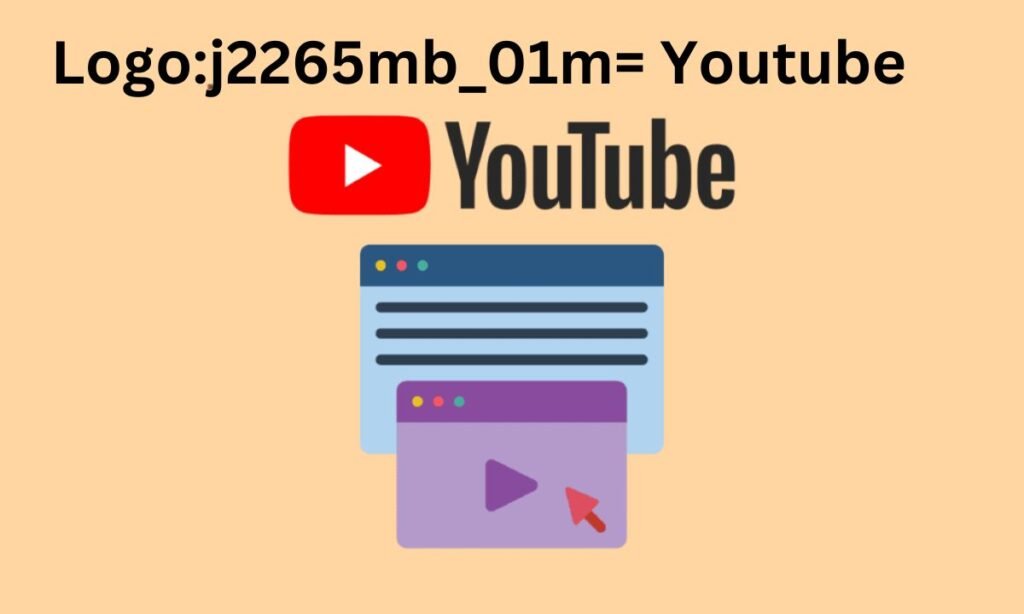
YouTube has become a dominant platform for content creators, businesses, and educators alike. With billions of active users each month, it offers unparalleled potential for reaching a global audience. In this comprehensive guide, we will explore the various aspects of Logo:j2265mb_01m= Youtube and how to utilize it effectively to grow your presence. From optimizing your channel and creating engaging content to mastering SEO and monetization, this guide will provide you with detailed insights to succeed on YouTube.
Understanding the Logo:j2265mb_01m= Youtube
Logo:j2265mb_01m= Youtube is more than just a video-sharing platform. It has evolved into a powerful tool for marketing, branding, and even education. Whether you are an aspiring content creator, a business owner looking to expand your online presence, or an influencer aiming to connect with your audience, YouTube offers endless opportunities.
The Global Reach of YouTube
With over 2 billion logged-in users monthly, YouTube is the second most visited site in the world, only behind Google. The sheer volume of potential viewers makes it a prime platform for anyone looking to share content. But with such a vast audience, comes great competition. Success on YouTube requires more than just uploading videos; it requires a strategic approach.
Optimizing Your YouTube Channel for Success
Your Logo:j2265mb_01m= Youtube channel is the cornerstone of your online presence. Optimizing it effectively can significantly enhance visibility and engagement. Below are essential strategies to ensure your channel stands out.
1. Crafting a Unique Channel Identity
Your channel identity should reflect your brand or niche. This involves carefully designing your channel banner, logo, and profile picture. These elements create the first impression on your audience, so ensure they are visually appealing and communicate your message clearly.
2. Writing an Effective Channel Description
Your channel description plays a crucial role in helping users and the YouTube algorithm understand your content. Incorporate relevant keywords that describe your niche or the value you offer. Mention your upload schedule, topics you cover, and any unique selling propositions. Be concise but informative, as this can encourage new visitors to subscribe.
3. Customizing Your Channel URL
A custom URL not only makes your channel easier to remember but also adds a professional touch. Once your channel meets the required eligibility (100 subscribers and other criteria), customize the URL to reflect your brand name or niche.
Creating Engaging and High-Quality Content
Content is the backbone of your YouTube channel. Quality and engagement are critical to keeping viewers returning and attracting new audiences.
1. Niche Focus: Stay Consistent
Identify your niche and create content around it. Viewers subscribe to channels because they expect consistent content on topics that interest them. Whether you’re into tech reviews, cooking tutorials, fitness, or travel vlogs, stick to a theme.
2. High-Quality Video and Audio
In today’s competitive YouTube environment, poor-quality videos won’t cut it. Invest in good equipment to ensure clear visuals and crisp audio. Use editing software to enhance your video production and maintain high standards throughout your uploads.
3. Engaging Introductions
The first few seconds of a video are crucial. If you don’t grab your viewers’ attention immediately, they may click away. Use compelling hooks, ask questions, or tease interesting content to come. The goal is to pique their interest right away.
4. Encourage Viewer Interaction
Interaction drives engagement and signals to YouTube’s algorithm that your content is valuable. Ask viewers to like, comment, and subscribe. Hosting Q&A sessions, polls, and replying to comments can foster a sense of community and boost retention rates.
Mastering YouTube SEO: Rank Higher in Searches
Search Engine Optimization (SEO) is essential to gaining visibility on Logo:j2265mb_01m= Youtube. By optimizing your videos for YouTube’s search engine, you can increase the chances of your content appearing in relevant searches.
1. Keyword Research
Start by researching keywords related to your niche. Use tools like Google Keyword Planner, TubeBuddy, or VidIQ to find high-volume, low-competition keywords. These keywords should guide your video titles, descriptions, and tags.
2. Optimizing Video Titles
Your video title is one of the most critical elements of SEO. It should be keyword-rich, descriptive, and enticing. For example, instead of “How to Bake a Cake,” opt for “How to Bake a Delicious Chocolate Cake in 10 Easy Steps.” Specificity and clarity can lead to more clicks.
3. Detailed Video Descriptions
Your video description provides additional context about your content. Write at least 200-300 words using relevant keywords. Include links to other videos, your website, and social media channels. Descriptions help the YouTube algorithm understand your content better, boosting the chances of your video being recommended.
4. Tags and Hashtags
Tags are vital in telling YouTube what your video is about. Use a combination of broad and specific tags that describe your content. Don’t overlook hashtags, either. You can add them in the video description to categorize your content, making it easier for viewers to find.
Monetization Strategies: Turning Your Channel into a Revenue Stream
Once you’ve established a solid presence on YouTube, it’s time to explore ways to monetize your channel. Logo:j2265mb_01m= Youtube offers several methods to help creators earn from their content.
1. Ad Revenue: The YouTube Partner Program
To earn money from ads, you need to join the YouTube Partner Program (YPP). Eligibility criteria include 1,000 subscribers and 4,000 hours of watch time in the past 12 months. Once accepted, YouTube will place ads on your videos, and you’ll earn a percentage of the ad revenue.
2. Sponsorships and Brand Deals
As your channel grows, you may attract the attention of brands looking to promote their products or services. Sponsorships can be highly lucrative, especially if you cater to a specific niche. Collaborating with brands can offer a significant boost to your revenue streams.
3. Affiliate Marketing
Affiliate marketing involves promoting products or services and earning a commission for each sale made through your referral link. Platforms like Amazon Associates allow you to embed affiliate links in your video descriptions. When viewers click through and make a purchase, you earn a percentage.
4. Channel Memberships and Super Chats
YouTube’s Channel Memberships and Super Chats allow subscribers to support you financially in exchange for exclusive perks. Memberships offer viewers benefits like custom emojis and badges, while Super Chats let fans donate during live streams.
Promoting Your Logo:j2265mb_01m= Youtube Channel: Expanding Your Reach
Growing a successful YouTube channel also requires efforts outside the platform. Promoting your videos on social media, collaborating with other creators, and engaging with your audience are key to driving traffic and increasing subscribers.
1. Leverage Social Media Platforms
Cross-promote your content on social media channels like Instagram, Twitter, and Facebook. Share video clips, behind-the-scenes footage, and engage with your audience. By building a multi-platform presence, you can increase your visibility and drive traffic to your YouTube channel.
2. Collaborate with Other Creators
Collaborations allow you to tap into another creator’s audience. Partnering with creators in your niche can expose your channel to a wider audience and foster valuable relationships within the community.
3. Email Marketing
Building an email list is another way to maintain consistent communication with your audience. Send out newsletters featuring new uploads, behind-the-scenes content, and exclusive insights. This keeps your subscribers engaged and drives repeat traffic to your channel.
Also Read More: Cute:h8n_qq6xy3c= Sanrio: Discover the World of Cuteness
Conclusion
In conclusion, building a successful Logo:j2265mb_01m= Youtube channel requires a combination of high-quality content, strategic SEO, and consistent audience engagement. Whether you are a business, influencer, or content creator, mastering the platform’s intricacies, from optimizing your channel to driving traffic through external promotion, can significantly enhance your visibility. With dedication, creativity, and the right tactics in place, YouTube can become a powerful tool for growth, brand exposure, and revenue generation. By following the strategies outlined in this guide, you will be well on your way to creating a thriving YouTube presence.
FAQs
1. How can I make my Logo:j2265mb_01m= Youtube videos rank higher in search results?
To rank higher, focus on Logo:j2265mb_01m= Youtube SEO by optimizing your video titles, descriptions, and tags with relevant keywords. Also, use engaging thumbnails, ensure high-quality content, and encourage viewers to like, comment, and subscribe. Consistent uploads and watch time also impact ranking.
2. What are the eligibility criteria to monetize my YouTube channel?
To monetize your channel through the YouTube Partner Program (YPP), you need at least 1,000 subscribers and 4,000 watch hours within the past 12 months. Once eligible, you can start earning from ad revenue and access additional monetization features like Super Chats and Channel Memberships.
3. What equipment do I need to start a YouTube channel?
At the very least, you’ll need a camera (even a smartphone with good video quality), a microphone for clear audio, and editing software to polish your videos. As your channel grows, investing in professional equipment like lighting and video cameras can help improve the production quality.
4. How do I grow my YouTube audience?
Growing your audience involves creating consistent content, engaging with your viewers through comments and community posts, collaborating with other creators, and promoting your channel across other platforms like social media. Using SEO to make your videos discoverable and focusing on a specific niche will also help attract and retain subscribers.
5. How often should I upload videos to YouTube?
Consistency is key. It’s better to have a regular schedule, such as weekly or biweekly uploads, so your audience knows when to expect new content. However, ensure that your videos maintain high quality and avoid compromising on value just to meet a tight schedule.

